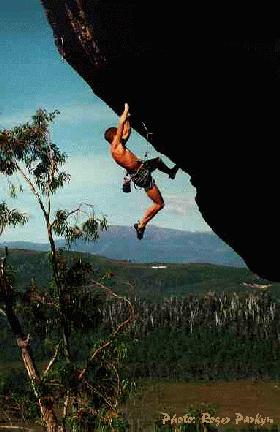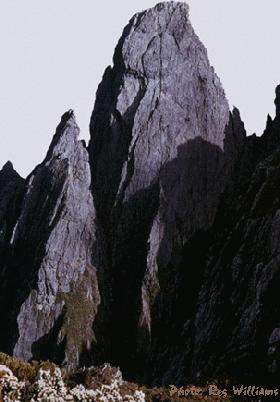About 50.
Climbing style
Adamsfield provides Tasmanian climbers with a very different medium to climb. The rock is very steep conglomerate as opposed to the columnar dolerite of most Tassie crags, and the area is the most well-known Tassie sport climbing area. The area has the State's only all-bolt ethic to avoid tatty threads and dodgy gear and has the highest concentration of hard, steep routes in Tasmania. A good flat and sheltered camping area exists behind Pyramid Rock, but there is no water. There are also a couple of caves formed by the boulders. Although the crag isn't in the National Park you have to pay the entry fee to be able to get there.
Guidebook
• As for most Tassie areas, buy the excellent "Craglets" (4th edition) paper guide.
• For the same info as in the paper guide and great photos, check out the Craglets online route guide.
How to get there [click for map]
Turn right down the road and drive for 16 km (from the Gordon Road) until a large boulder sticks out on the right, nearly overhanging the road (this is the climb Roadkill!). A top-rope problem also exists on this boulder and is about grade 17. Only 50 metres on from this it is possible to park on the left, opposite a slimy looking bank. Walk up this bank with a little difficulty, then head up to the right through bracken and bushes for about 100 metres to the large boulder. This boulder is known as The High Wire. Follow the blue tapes up the hill to the top of the hill to find Pyramid Rock and the Bear Pit, follow the orange tapes to the Trapeze.
Most of this info comes directly from the Craglets online route guide. Thanks to Roger Parkyn and Sam Edwards. The Adamsfield cliffs are situated at Grid reference 715430 on the Wedge 1:100 000 map at the northern end of the Ragged Range, about 35 km past Maydena. Once you have driven past Maydena, continue into the National Park along the Gordon River road, driving past the Scotts peak dam turn off (Frodshams Pass). About 5 km on from here, the road will be heading downhill. After passing several minor offshoots, a sign indicates "Clear Hill Road", follow this.
Associated links and references
• Craglets (4th edition) paper guide
• Craglets online guide and photos
• Nermut's overview and photos

Above: Sam Edwards working Forearm Flameout (27).
Photo: Roger Parkyn



